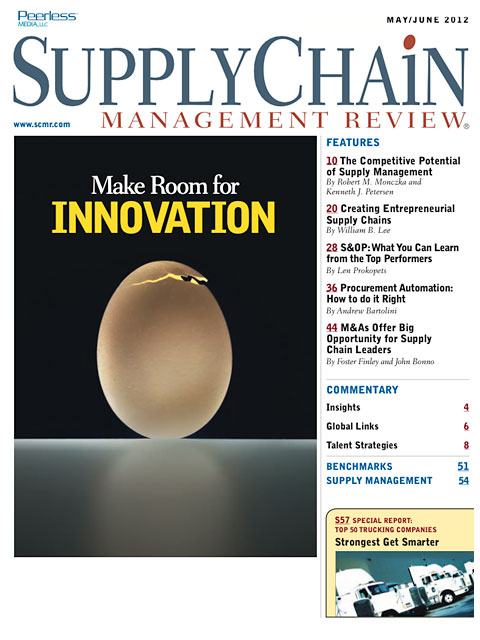Sorry, but your login has failed. Please recheck your login information and resubmit. If your subscription has expired, renew here.
May-June 2012
Supply management can be a powerful competitive weapon—if the strategy driving that activity is closely aligned with the business strategy. Yet new research suggests that the necessary alignment is often lacking. CAPS Research experts offer a process for identifying and implementing the supply management strategies that hold maximum potential for competitive advantage. Browse this issue archive.Need Help? Contact customer service 847-559-7581 More options
Firms around the world are developing and adapting business strategy in order to meet an ever-changing global marketplace. These changing business strategies are frequently driven by downward price pressure, more complicated global supply chains, increasing global competition, heightened customer value expectations, changing population demographics, increasing demand for environmentally safe products, rapidly changing technology, and growing stakeholder demands.
In this dynamic environment, supply management strategies must align with and support rapidly changing business strategy. In fact, when this alignment is lacking, supply management simply cannot properly support the business. For example, supply management may focus on delivering business value through the negotiation of improved pricing, when the business actually needs insight into suppliers’ process and technology innovation.
In this case, the supplier will certainly understand that they are primarily competing on price and then appropriately choose to withhold their valuable insight into process and technology innovation.
For most organizations, the close and continuing alignment of supply management strategies with business strategy represents a transformational supply management change. In this article, we suggest a process to help supply management professionals undertake this transformational change in a fast and effective way. Our discussion is based on the most recent CAPS Research Executive Assessment of Supply (EAS). (For more on this research, see accompanying sidebar.) We describe the current state of supply management, suggest a future state of supply management strategy, point to those opportunities for strategy development and improvement, and then outline a process for achieving the necessary supply management transformation. Our goal is to give forward-looking supply executives a view of where they might most effectively apply resources in order to close gaps—and in so doing better support business strategy and contribute to their companies’ competitiveness.
 |
This complete article is available to subscribers
only. Click on Log In Now at the top of this article for full access. Or, Start your PLUS+ subscription for instant access. |
Not ready to subscribe, but need this article?
Buy the complete article now. Only $20.00. Instant PDF Download.
Access the complete issue of Supply Chain Management Review magazine featuring
this article including every word, chart and table exactly as it appeared in the magazine.
SC
MR
Sorry, but your login has failed. Please recheck your login information and resubmit. If your subscription has expired, renew here.
May-June 2012
Supply management can be a powerful competitive weapon—if the strategy driving that activity is closely aligned with the business strategy. Yet new research suggests that the necessary alignment is often lacking.… Browse this issue archive. Download a PDF file of the May-June 2012 issue.
 |
Download Article PDF |
Firms around the world are developing and adapting business strategy in order to meet an ever-changing global marketplace. These changing business strategies are frequently driven by downward price pressure, more complicated global supply chains, increasing global competition, heightened customer value expectations, changing population demographics, increasing demand for environmentally safe products, rapidly changing technology, and growing stakeholder demands.
In this dynamic environment, supply management strategies must align with and support rapidly changing business strategy. In fact, when this alignment is lacking, supply management simply cannot properly support the business. For example, supply management may focus on delivering business value through the negotiation of improved pricing, when the business actually needs insight into suppliers’ process and technology innovation.
In this case, the supplier will certainly understand that they are primarily competing on price and then appropriately choose to withhold their valuable insight into process and technology innovation.
For most organizations, the close and continuing alignment of supply management strategies with business strategy represents a transformational supply management change. In this article, we suggest a process to help supply management professionals undertake this transformational change in a fast and effective way. Our discussion is based on the most recent CAPS Research Executive Assessment of Supply (EAS). (For more on this research, see accompanying sidebar.) We describe the current state of supply management, suggest a future state of supply management strategy, point to those opportunities for strategy development and improvement, and then outline a process for achieving the necessary supply management transformation. Our goal is to give forward-looking supply executives a view of where they might most effectively apply resources in order to close gaps—and in so doing better support business strategy and contribute to their companies’ competitiveness.
 |
SUBSCRIBERS: Click here to download PDF of the full article. |
SC
MR

Latest Supply Chain News
- Services sector sees growth in October, reports ISM
- Balanced supply chain management Part 4: The key—leading beyond the silo
- Managing inbound freight: What has changed in two decades?
- Inbound freight: Often a missed opportunity
- Aggregators sitting on the throne of Africa’s e-commerce supply chains: What lessons can we learn?
- More News
Latest Resources

 Explore
Explore
Topics
Latest Supply Chain News
- Services sector sees growth in October, reports ISM
- Balanced supply chain management Part 4: The key—leading beyond the silo
- Managing inbound freight: What has changed in two decades?
- Inbound freight: Often a missed opportunity
- Aggregators sitting on the throne of Africa’s e-commerce supply chains: What lessons can we learn?
- Cross-border transport 2024: Navigating the surge
- More latest news
Latest Resources

Subscribe

Supply Chain Management Review delivers the best industry content.

Editors’ Picks





